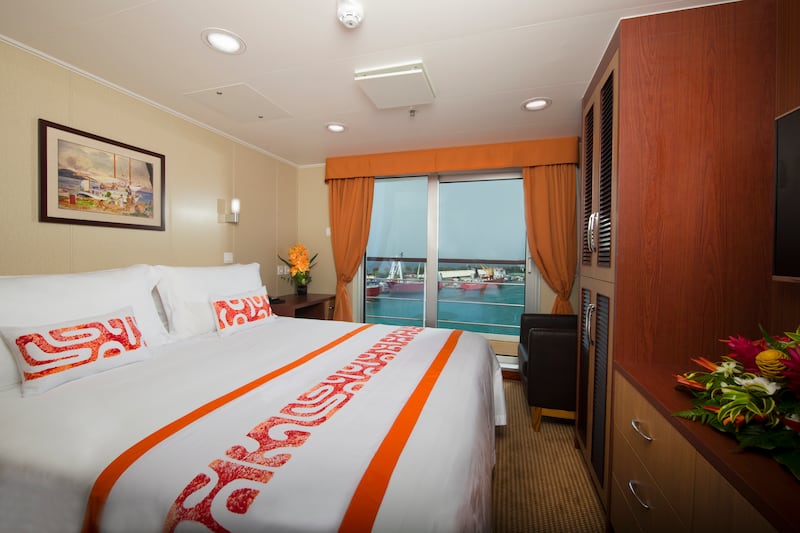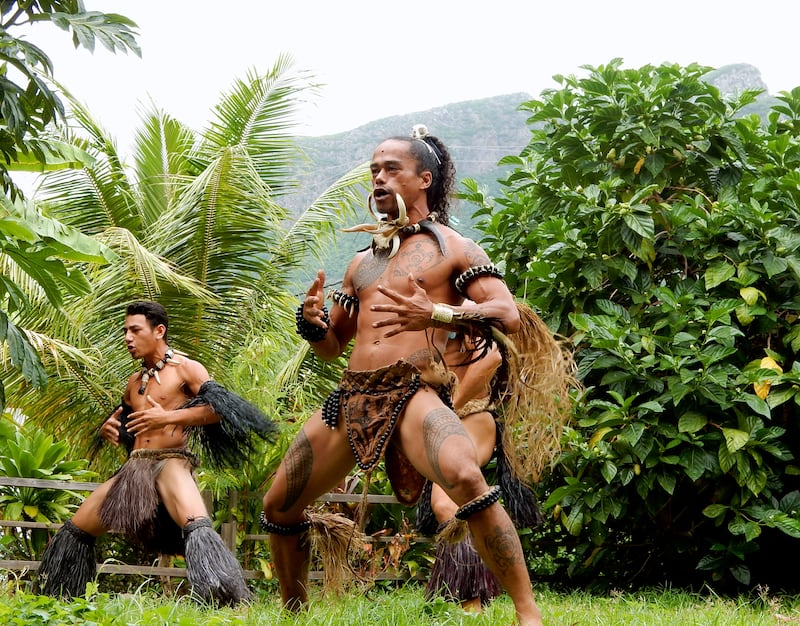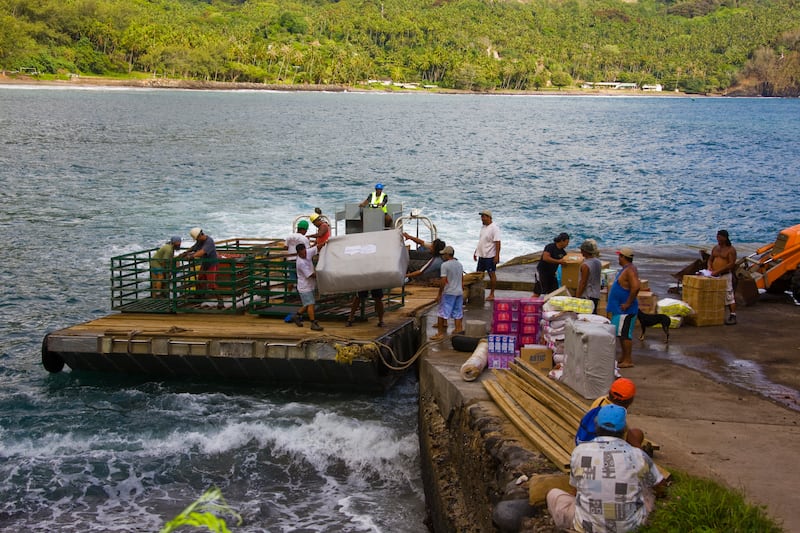They’re loading mangoes on UA Huka. We are waiting in the shade, watching crates of luscious fruit being transferred to a barge for the Aranui 5. We will follow, stepping from rocking barge to steady ship when the waves allow. The fruit is taking the place of the supplies that came with us: cement, sugar and other staples.
The Aranui herself is further up the deep ravine, tied to precipitous rocks, prevented from coming further by a hidden sandbank. There are bananas too, and copra, a coconut byproduct that appears to be good for everything – from building to feeding animals.
The Aranui is a cargo ship that is also a cruise ship, serving the Marquesa Islands, a lush Polynesian archipelago south of Tahiti. The ship is an intriguing mash up that looks a bit weird initially, but soon makes total sense.
Why not cut a cargo ship in half and add on some staterooms, sun decks and a swimming pool? Actually, it is far more sophisticated than that and, alongside a pair of on-board cranes and a cargo capacity of 3,000 tons, there are cabins, staterooms and suites, a restaurant, lounge, three bars, conference rooms and a tattoo studio.
READ MORE

Moana, who is the restaurant manager, plays the ukulele some evenings and is the resident tattoo artist. At first I wondered at this, but Marquesan tattoos are a thing, and so are ukuleles, although they actually originated in Hawaii. Moana excels at both.
Most of the crew double up: stevedores at port may end up helping on the passenger side at sea, and things are happily informal, which means everyone mingles. As there is capacity for just 230 in 103 cabins, you can easily make new friends, or avoid them if the mood takes you.
Cruising on the Aranui is an incredible adventure that brings you just under a thousand miles from Tahiti, through the turquoise lagoons that inspired Henri Matisse to start using different colours, to the remote cluster of islands, where an astonishing array of people, including Paul Gauguin and Jacques Brel, ended up. Officially in French Polynesia, the Marquesa Islands are thoroughly beautiful, while also encompassing a cluster of opposites: lush and rugged, powerful but fragile, presided over by a mingling of Christian and more ancient gods, and celebrated in art and literature yet also remarkably untouched. The people are warm, friendly and open, but may be smiling at you from behind striking facial tattoos and necklaces of animal tusks.
Herman Melville jumped ship here and wrote Typee, based on his time on Nuku Hiva, while dreaming up Moby Dick. Robert Louis Stephenson picked up ideas for Treasure Island in these parts. Paul Gauguin discovered his island paradise, though he sullied it with the liberties he took with the freedoms he found; and Jacques Brel found peace and sanctuary on Hiva Oa. The graves of both artists are close to one another on Hiva Oa, in a little cemetery high above the town.
Sited on a volcanic plateau, which means you get incredible mountains and rock formations, each island has its own character. On UA Huka, there is only one road, which runs along one side of the island. The other side is populated by 1,500 wild horses, and 3,000 goats. In a lush valley we find a group of musicians playing. One man has made a stringed instrument out of a plastic bin, which has a surprisingly powerful sound, while another has the face of a French philosopher and plays the ukulele while smoking a pipe.
Nuku Hiva has winding precipitous roads, dense forests with carved rocks, and an epic banyan tree, said to have once been filled with sacrificial skulls. We are met everywhere with dancing and music, and realise that there is a different kind of welcome when you’re arriving with supplies, rather than simply as a tourist. On UA Huka almost every car on the island has been driven to the harbour to bring us to the Botanical Gardens, and they are decorated with flowers and fresh fruit, scenting up the dashboards. When the trip of a lifetime is also a local delivery lifeline, you tend to feel less guilty about the carbon costs of travel.
We are shown around a Tohua (ceremonial plaza), where there is a large flat rock balanced on two boulders. “That’s the circumcision platform,” says our guide. I’m glad I didn’t choose to sit there. We find a rocky beach on Ua Po where the stones are shot through with fossils in the shape of flowers; and a beautiful bay where it is so hot, and the water looks so enticing, I get over the lack of swimming togs by doing something clever with a sarong.
Returning to the Aranui, we find local kids using the ropes tying the ship as a diving board. They are having so much fun I wish I had the guts to join in. I’m sure it’s very safe. We have been warned that the chief dangers are falling coconuts and stone fish, although strong currents can feature in places.
Tahiti and the Marquesa Islands are a French Protectorate, which means French is widely spoken, along with Tahitian, and a range of local dialects. English will get you by though, and I make friends with some nice Canadians who are mainly retired teachers, plus some Americans, and a Belgian chemist and her Swiss astrophysicist husband who is hoping to discover what happened before the Big Bang.
“He thinks he knows everything,” his wife says. Perhaps he does. I don’t get to find out, as the conversation moves on to Abba. Dinner is served at shared tables, so we all have plenty of opportunity for chats over good food. There is a French marine biologist who thinks people aren’t so very different from fish (it’s all about leaders, bullies and followers apparently).
One of the Americans turns out to have been David Hasselhoff’s double out of Baywatch. He’s great fun and has stories from on-set which I’m not sure are repeatable, so I won’t, but he does say you get the best view of him in an episode where he kicks a fake shark. He tells me that with his background in lifeguarding, it’s hard to ever fully relax on a beach, which is fortunate, as he will later save the Belgian chemist, and his own wife from being dragged out by a rip tide at Puamau. The captain rewards him with three mangoes, although we decide to add champagne, and we toast the happy outcome that night under the stars of the Southern Cross.
We’ve been greeted with beads, entertained with ukuleles, and marvelled at the dancing. When the French Catholic colonists arrived, they quickly banned human sacrifice, cannibalism and Marquesan dancing, which has a lot to do with the Haka. Such a ban might seem a bit much, until you see some of the moves and realise why controlling moralists may have been worried.

I buy a cold coconut from a man sitting under an umbrella. He hacks off the top and sticks in a straw. “Coconut, coconut,” says a small girl, trying out my accent. It’s blissful.
Over breakfast one morning I meet a woman who was born in the Indian Ocean. Or rather on it. Her French father had packed up his family, sometime at the end of the 1960s, and set off on a 10m boat, looking, she said, for happiness. He had never sailed before, but they roamed the world, before fetching up in Tahiti, and then stayed on somewhere off Bora Bora. He’s now dead, and she studies explorers: Wallis, Cook, and Bougainville, who gave his name to the beautiful bright flowers.
She tells me the Mutiny on the Bounty, which took place in this neck of the woods, was essentially driven by breadfruit. Having eaten it, I’m not surprised it caused unrest, though it is surprisingly delicious when turned into crisps at Happy Hour, which soon becomes a welcome feature of life aboard ship. We gather on deck and sip exotic cocktails as the sun sets in a succession of glorious displays. The crew are lovely, and inclined to hug you if they like you, and I find I’m inclined to enjoy it.
There are lectures on board, ukulele and dancing classes, and a fashion show with plucky passengers as models. Participation is not obligatory, but it is good craic. The vibe on the Aranui is extremely comfortable, rather than the ultra luxury of a dedicated cruise ship, and I explore different cabins. At sea level, the water rushes past a porthole in a way that makes you think either of racing the waves, or being in a washing machine, depending on the romanticism of your soul. Higher up there are fancier staterooms, and suites with balconies. I develop the habit of sleeping the first part of the night on the balcony under the stars, as the ship pitches and rolls, before moving indoors to my remarkably restful bed.
They say the best trips leave an indelible mark on your soul, and the people and sights of the Aranui 5 and the Marquesas are definitely etched on mine, as is a small Tiki on my ankle. A tattoo studio on a cargo cruise ship? How could I resist?
Gemma Tipton travelled as a guest of Aranui and Air Tahiti Nui
Getting there
The Aranui 5 departs from Papeete, the capital of Tahiti. Fly from Paris with Air Tahiti Nui, via a short layover at Los Angeles. As the flight transits the US, you will need an up-to-date ESTA: apply in advance online at a cost of about €20, dhs.gov. Currently Covid tests are not required, but vaccination certificates are checked. A full service airline, Air Tahiti Nui reminds you of when all airlines used to be nice to you as a matter of course. Delicate jasmine flowers – handed out on take-off, even right at the back of the plane – filled the cabin with fragrant scent, and won us all over from the start. Return flights from €1,633.89 including tax. airtahitinui.com
Cruising on the Aranui 5
Cruising with cargo on selected dates throughout the year, the 12-day trip on board Aranui 5 costs €4,623 pps in a double stateroom with obstructed view, or €3,021 for a bunk in a shared cabin. Including all meals, wine with meals, taxes and scheduled excursions, aranui.com
Cruising without cargo
The Aranui also makes trips to the Cook and Society Islands Cruise: try lagoon hopping for nine days from April 17th at a discounted rate of €4,514.28 pps. Or take the Austral Islands Cruise, departing September 9th, with a 12-day cruise from €5,497.03 pps. Book now for a 20 per cent discount, or no single supplement. Alternatively, follow in the footsteps (or sails?) of the Bounty Mutineers, departing October 7th for an 11-day trip to Pitcairn from €5,444 pps. All trips include all meals, wine with meals, taxes and scheduled excursions, but exclude international flights. Book direct at aranui.com

What to bring
The Aranui is well appointed and well equipped, with drinking water dispensers on every floor, so bring a water bottle to make the most of it. Other essentials include: sun hat, sun screen, light backpack, sea shoes to dispel stone fish anxieties, mosquito repellent and bug bite cream for when the repellent doesn’t quite do the job. I suffer badly with bites, but my pharmacist’s tip, to take an antihistamine for a week before departure and throughout, helped enormously.
The currency is Polynesian Francs. Move the decimal point up two places for an approximate exchange rate. Make sure to bring local currency, as many of the islands don’t have credit card facilities. You’ll find handy ATMs in Papeete.
Wifi in the Marquesas
Can’t bear to be out of coverage on the far side of the world? There is wifi on the Aranui, but it is expensive and works only in sight of land. A better bet is to book a Tahiti wifi mobile hub in advance, to pick up at Papeete airport on arrival. Coverage is patchy on the more remote islands, from €39, tahitiwifi.com. For the best coverage, ask your provider to unlock your sim before departure, and buy a sim from the Vini store in Papeete from €33. This gives you a new phone number for the duration, but good coverage on, and in sight of the islands, and on Tahiti itself, vini.pf
24 hours in Papeete
The Aranui 5 departs from the marina in downtown Papeete. For maximum convenience I stayed at the Kon Tiki Hotel, directly opposite the docks. Rooms range from windowless boxes with shared bathrooms, to very nice doubles with views. There is also a rooftop restaurant. Take the windowless box to crash out in peace from about €125 a night, and think how you would have sold your soul for such an arrangement on the long flight over. kontikitahiti.com
Papeete itself is charming if a little grungy in places, and is perfectly safe. Visit the market for black pearls, crafts and a peek at all the flowers, fruit and fish for sale. There’s a nice walk along the waterfront, where you’ll find some bars and restaurants. Have a full day at your disposal? Take the ferry to Moorea (about €35 return) for beautiful golden beaches, warm waters and tropical island bliss. Journey time about 30 minutes. aremiti.pf.





















